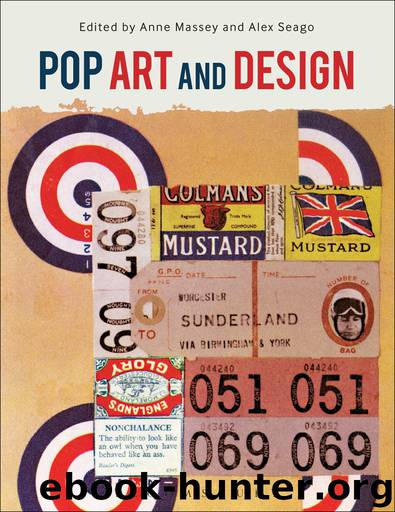Pop Art and Design by Massey Anne Seago Alex

Author:Massey, Anne,Seago, Alex
Language: eng
Format: epub
ISBN: 9781474226219
Publisher: Bloomsbury UK
Published: 2017-03-18T04:00:00+00:00
ARK Magazine: The Royal College of Art and Early British Art School Pop
Alex Seago
Pop was a resistance movement: a classless commando which was directed against the Establishment in general and the art-Establishment in particular … Pop was meant as a cultural break, signifying the firing-squad, without mercy or reprieve, for the kind of people who believed in Loeb classics, holidays in Tuscany, drawings by Augustus John, signed pieces of French furniture, leading articles in The Daily Telegraph and very good clothes that lasted for ever (Russell and Gablik 1969: xi).
Between the mid-1950s and early 1960s British culture was propelled into a new era by young visual revolutionaries who transformed the face of British art, fashion, film, television, advertising, newspapers and magazines. Responsible for setting the pendulum of the image-obsessed ‘Swinging Sixties’ in motion, many such ‘neophiliacs’ (Booker 1969) were alumni of London’s Royal College of Art. Within the RCA the epicentre of this movement was the School of Graphic Design, whose magazine ARK provides a fascinating insight into the development of peculiarly English Pop sensibility – an attitude and outlook that requires historical and cultural contextualization.
ARK, The Journal of the Royal College of Art was established in 1950 on the initiative of Jack Stafford, a student in the RCA’s School of Woods, Metals and Plastics. In his editorial for the first issue he stated that the purpose of the magazine would be to ‘explore the elusive but necessary relationships between the arts and the social context’, an object of enquiry which remained relatively consistent throughout the magazine’s twenty-five-year history and which makes it such a valuable archive for anyone interested in disentangling the complex ‘little narratives’ of British design history during the 1950s and early to mid-1960s.
ARK was initially produced in the style of contemporary ‘little magazines’ such as John Lehmann’s Penguin New Writing. It assumed a literary tone characteristic of a pre-television era when rationing, paper shortages and restrictions on inessential imports ensured that visual material was in short supply and reading was one of the few forms of entertainment. Appearing three times a year, with a full-time editor responsible for an annual edition and a separate team of student graphic designers responsible for every issue, the initial print run was 2,000, peaking at 3,000 in 1963 – by which time ARK could boast a global list of subscribers. While the high turnover of editors and art editors resulted in an almost total lack of stylistic unity or thematic continuity, ARK was far more professionally produced than almost any other student publication of the period – perhaps only surpassed by Cambridge University’s Granta. Although it seldom managed to break-even, the magazine aimed to be self-financing and was available by subscription or over the counter at art booksellers such as London’s Zwemmer’s or Better Books. The magazine also relied heavily on advertising revenue charitably supplied by companies with strong links to the RCA via their directors’ membership of College Council, including Schweppes, Gilbey’s Gin, the Orient Line, Murphy’s Radios, and
Download
This site does not store any files on its server. We only index and link to content provided by other sites. Please contact the content providers to delete copyright contents if any and email us, we'll remove relevant links or contents immediately.
Wonder by R.J. Palacio(8384)
Mastering Adobe Animate 2023 - Third Edition by Joseph Labrecque(3634)
Unlabel: Selling You Without Selling Out by Marc Ecko(3556)
Ogilvy on Advertising by David Ogilvy(3456)
Drawing Cutting Edge Anatomy by Christopher Hart(3422)
Hidden Persuasion: 33 psychological influence techniques in advertising by Marc Andrews & Matthijs van Leeuwen & Rick van Baaren(3416)
The Pixar Touch by David A. Price(3331)
POP by Steven Heller(3281)
The Code Book by Simon Singh(3023)
Slugfest by Reed Tucker(2898)
The Art of War Visualized by Jessica Hagy(2892)
The Curated Closet by Anuschka Rees(2881)
Rapid Viz: A New Method for the Rapid Visualization of Ideas by Kurt Hanks & Larry Belliston(2796)
Stacked Decks by The Rotenberg Collection(2773)
365 Days of Wonder by R.J. Palacio(2713)
The Wardrobe Wakeup by Lois Joy Johnson(2700)
Keep Going by Austin Kleon(2663)
Tattoo Art by Doralba Picerno(2565)
Tell Me More by Kelly Corrigan(2564)
